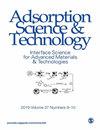The Absorption and Distribution of Heavy Metals of Dominant Plant for Ecological Restoration of Stone Coal Mine
IF 3.2
4区 工程技术
Q2 CHEMISTRY, APPLIED
引用次数: 0
Abstract
The exposed slopes formed by stone mining had caused serious problems of environmental pollution. The ecological restoration was a very effective measure to solve it. In this study, the Indigofera amblyantha Craib was the dominant species in the ecorestoration during the first two years of ecological restoration, which was based on analyzing the importance value (IV) and diversity indexes of plant species. Meanwhile, the ecorestoration process helps slow down the increase of the concentrations of some heavy metals in the substrate material; however, the changing trends of these metals were not uniform. The root and leaf were the main parts of heavy metal distribution, respectively, corresponding to Pb, Cr, As, Sb, and Ni in root and Cu, Mn, and V in leaf. It confirmed that Indigofera amblyantha Craib had an advantage ability to enrich and transfer Cd, Cu, and Mn obtained from their biological concentration factor (BCF) and biological transfer factor (BTF). The Sb, Cd, and V were the main factors affecting the IV by the redundancy analysis. These fine characters of Indigofera amblyantha Craib help explain it well adapted to the ecorestoration of stone coal mines. The current results are valuable to evaluate and extend the application in ecorestoration engineering of mining areas and other heavy metal-contaminated sites.石煤矿山生态修复优势植物对重金属的吸收与分布
采石形成的裸露边坡造成了严重的环境污染问题。生态恢复是解决这一问题的有效措施。本研究在分析植物物种重要性值(IV)和多样性指数的基础上,确定了在生态恢复的前两年,蓝靛蓝是生态恢复的优势物种。同时,生态还原过程有助于减缓基质材料中某些重金属浓度的增加;然而,这些金属的变化趋势并不一致。根和叶是重金属分布的主要部分,分别对应于根中的Pb、Cr、As、Sb和Ni以及叶中的Cu、Mn和V。结果表明,蓝靛蓝具有富集和转移Cd、Cu、Mn的优势。通过冗余度分析,Sb、Cd和V是影响IV的主要因素。蓝靛的这些优良性状有助于解释其与石质煤矿生态环境的适应性。研究结果对评价和推广矿区及其他重金属污染场地生态修复工程的应用具有一定的参考价值。
本文章由计算机程序翻译,如有差异,请以英文原文为准。
求助全文
约1分钟内获得全文
求助全文
来源期刊

Adsorption Science & Technology
工程技术-工程:化工
CiteScore
5.00
自引率
10.30%
发文量
181
审稿时长
4.5 months
期刊介绍:
Adsorption Science & Technology is a peer-reviewed, open access journal devoted to studies of adsorption and desorption phenomena, which publishes original research papers and critical review articles, with occasional special issues relating to particular topics and symposia.
 求助内容:
求助内容: 应助结果提醒方式:
应助结果提醒方式:


